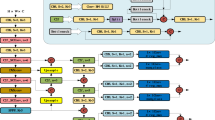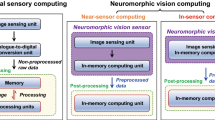Abstract
The contradiction between the high number of visually handicapped people and the scarcity of guide dogs has stimulated the demand for electronic guide dogs (EGDs). Here, we demonstrate an EGD by leveraging piezoresistors on a MoS2/Ge heterostructure for simultaneous pressure-sensing and optical-sensing functions. The device has excellent gating capability and exhibits large positive and negative photoresponses under visible (532 nm, 182 A/W) and infrared (1550 nm, 37 A/W) illumination. These characteristics allow the device to efficiently classify different obstacles at all times of day using pressure and light signals. The device reaches nearly 100% accuracy after 48 training sessions when used to classify frequent scenes. The device adopts passive and active detection modes during the day and night, respectively, which improves the battery life of the EGD. This work provides a significant reference for the future design of EGDs, which may help a greater number of visually impaired people by reducing the cost of such devices.

Similar content being viewed by others
References
Gori, M.; Cappagli, G.; Tonelli, A.; Baud-Bovy, G.; Finocchietti, S. Devices for visually impaired people: High technological devices with low user acceptance and no adaptability for children. Neurosci. Biobehav. Rev. 2016, 69, 79–88.
Hu, M. H.; Chen, Y. Z.; Zhai, G. T.; Gao, Z. P.; Fan, L. An overview of assistive devices for blind and visually impaired people. Int. J. Rob. Autom. 2019, 34, 580–589.
Sielicki, I.; Bartkowski, Z.; Bartkowska, J. Significance of colors and contrasts in the life of the visually impaired. In Proceedings of SPIE 4535, Optical Sensing for Public Safety, Health, and Security, Warsaw, pp 41–44.
King, G. A.; Shultz, I. Z.; Steel, K.; Gilpin, M.; Cathers, T. Self-evaluation and self-concept of adolescents with physical disabilities. Am. J. Occup. Ther. 1993, 47, 132–140.
Roe, J.; Webster, A. Children with Visual Impairments: Social Interaction, Language and Learning; Routledge: London, 1998.
West, S. K.; Rubin, G. S.; Broman, A. T.; MuMuñozoz, B.; Bandeen-Roche, K.; Turano, K. How does visual impairment affect performance on tasks of everyday life. The SEE project. Arch. Ophthalmol. 2002, 720, 774–780.
Whitmarsh, L. The benefits of guide dog ownership. Visual Impairment Res. 2005, 7, 27–42.
Wiggett-Barnard, C.; Steel, H. The experience of owning a guide dog. Disabil. Rehabil. 2008, 30, 1014–1026.
Camp, M. M. The use of service dogs as an adaptive strategy: A qualitative study. Am. J. Occup. Ther. 2001, 55, 509–517.
Hong, B.; Lin, Z. X.; Chen, X.; Hou, J.; Lv, S. Y.; Gao, Z. D. Development and application of key technologies for guide dog robot: A systematic literature review. Rob. Auton. Syst. 2022, 154, 104104.
McIver, S.; Hall, S.; Mills, D. S. The impact of owning a guide dog on owners’ quality of life: A longitudinal study. Anthrozoö s 2020, 33, 103–117.
Batt, L.; Batt, M.; Baguley, J.; McGreevy, P. The effects of structured sessions for juvenile training and socialization on guide dog success and puppy-raiser participation. J. Vet. Behav. 2008, 3, 199–206.
Batt, L. S.; Batt, M. S.; Baguley, J. A.; McGreevy, P. D. Factors associated with success in guide dog training. J. Vet. Behav. 2008, 3, 143–151.
Bray, E. E.; Sammel, M. D.; Cheney, D. L.; Serpell, J. A.; Seyfarth, R. M. Effects of maternal investment, temperament, and cognition on guide dog success. Proc. Natl. Acad. Sci. USA 2017, 144, 9128–9133.
Murphy, J. A. Describing categories of temperament in potential guide dogs for the blind. Appl. Anim. Behav. Sci. 1998, 58, 163–178.
Ulrich, I.; Borenstein, J. The GuideCane-applying mobile robot technologies to assist the visually impaired. IEEE Trans. Syst. Man Cybern A Syst. Hum. 2001, 31, 131–136.
Bruno, D. R.; De Assis, M. H.; Osorio, F. S. Development of a mobile robot: Robotic guide dog for aid of visual disabilities in urban environments. In Proceedings of the 2019 Latin American Robotics Symposium (LARS), 2019 Brazilian Symposium on Robotics (SBR) and 2019 Workshop on Robotics in Education (WRE), Rio Grande, 2019, pp 104–108.
Due, B. L. Guide dog versus robot dog: Assembling visually impaired people with non-human agents and achieving assisted mobility through distributed co-constructed perception. Mobilities 2023, 18, 148–166.
Feng, C.; Azenkot, S.; Cakmak, M. Designing a robot guide for blind people in indoor environments. In Proceedings of the Tenth Annual ACM/IEEE International Conference on Human-Robot Interaction Extended Abstracts, Portland, 2015, pp 107–108.
Gao, T.; Chen, C. Y.; Ou, H. Y.; Wen, X. L.; Yang, Y. C.; Xie, Y. Z. Product design of intelligent blind guide stick based on humanistic care. In 2022 3rd International Conference on Language, Art and Cultural Exchange (ICLACE 2022), Amsterdam, 2022, pp 757–762.
Huang, C. Q.; Liu, L. L. Application of the constitutive model in finite element simulation: Predicting the flow behavior for 5754 aluminum alloy during hot working. Metals 2017, 7, 331.
Kulkarni, A.; Wang, A.; Urbina, L.; Steinfeld, A.; Dias, B. Robotic assistance in indoor navigation for people who are blind. In 2016 11th ACM/IEEE International Conference on Human-Robot Interaction (HRI), Christchurch, 2016, pp 461–462.
Wei, Y.; Lee, M. A guide-dog robot system research for the visually impaired. In 2014 IEEE International Conference on Industrial Technology (ICIT), 2014; pp 800–805.
Saegusa, S.; Yasuda, Y.; Uratani, Y.; Tanaka, E.; Makino, T.; Chang, J. Y. Development of a guide-dog robot: Leading and recognizing a visually-handicapped person using a LRF. J. Adv. Mech. Des. Syst. Manuf. 2010, 4, 194–205.
Tachi, S.; Tanie, K.; Komoriya, K.; Abe, M. Electrocutaneous communication in a guide dog robot (MELDOG). IEEE Trans. Biomed. Eng. 1985, BME-32, 461–469.
Tachi, S.; Tanie, K.; Komoriya, K.; Hosoda, Y.; Abe, M. Guide dog robot—Its basic plan and some experiments with Meldog Mark I. Mech. Mach. Theory 1981, 16, 21–29.
Zeng, J.; Yang, P.; Xu, C. M.; Jiang, S. Q.; Peng, D. G. Design and implementation of guide-dog robot. Mechatronics 2005, 11, 22–25.
Wu, X. M.; Li, E. L.; Liu, Y. Q.; Lin, W. K.; Yu, R. J.; Chen, G. X.; Hu, Y. Y.; Chen, H. P.; Guo, T. L. Artificial multisensory integration nervous system with haptic and iconic perception behaviors. Nano Energy 2021, 85, 106000.
You, J.; Wang, L. M.; Zhang, Y. C.; Lin, D. D.; Wang, B.; Han, Z.; Zhang, N. N.; Miao, T.; Liu, M. L.; Jiang, Z. M. et al. Simulating tactile and visual multisensory behaviour in humans based on an MoS2 field effect transistor. Nano Res., 2023, 16, 7405–7412.
Yu, J. R.; Yang, X. X.; Gao, G. Y.; Xiong, Y.; Wang, Y. F.; Han, J.; Chen, Y. H.; Zhang, H.; Sun, Q. J.; Wang, Z. L. Bioinspired mechano-photonic artificial synapse based on graphene/MoS2 heterostructure. Sci. Adv. 2021, 7, eabd9117.
Zhang, Z. X.; Shi, Q. F.; He, T. Y. Y.; Guo, X. G.; Dong, B. W.; Lee, J.; Lee, C. Artificial intelligence of toilet (AI-toilet) for an integrated health monitoring system (IHMS) using smart triboelectric pressure sensors and image sensor. Nano Energy 2021, 12, 106517.
Pi, L.; Wang, P.; Liang, S.-J.; Luo, P.; Wang, H.; Li, D.; Li, Z.; Chen, P.; Zhou, X.; Miao, F.; Zhai, T. Broadband convolutional processing using band-alignment-tunable heterostructures. Nature Electronics 2022, 5, 248–254.
Wang, Y.; Gan, L.; Chen, J.; Yang, R.; Zhai, T. Achieving highly uniform two-dimensional PbI(2) flakes for photodetectors via space confined physical vapor deposition. Sci Bull 2017, 62, 1654–1662.
Zhang, Q.; Gao, W.; Xiong, Q. Advanced optical gain materials keep on giving. Science China Materials 2020, 63, 1345–1347.
Wang, C.-Y.; Liang, S.-J.; Wang, S.; Wang, P.; Li, Z. A.; Wang, Z.; Gao, A.; Pan, C.; Liu, C.; Liu, J. Gate-tunable van der Waals heterostructure for reconfigurable neural network vision sensor. Science Advances 2020, 6, eaba6173.
Zha, C.; Yan, X.; Yuan, X.; Zhang, Y.; Zhang, X. An artificial optoelectronic synapse based on an InAs nanowire phototransistor with negative photoresponse. Optical and Quantum Electronics 2021, 53.
Zhang, Z.; Wang, S.; Liu, C.; Xie, R.; Hu, W.; Zhou, P. All-in-one two-dimensional retinomorphic hardware device for motion detection and recognition. Nat Nanotechnol 2022, 17, 27–32.
Wang, B.; Wang, L.; Zhang, Y.; Yang, M.; Lin, D.; Zhang, N.; Jiang, Z.; Liu, M.; Zhu, Z.; Hu, H. Mixed-dimensional MoS2/Ge heterostructure junction field—Effect transistors for logic operation and photodetection. Advanced Functional Materials 2021, 32.
Jiang, Y.; Chen, S.; Zheng, W.; Zheng, B.; Pan, A. Interlayer exciton formation, relaxation, and transport in TMD van der Waals heterostructures. Light Sci Appl 2021, 12, 72.
Street, R. A. Electronic structure and properties of organic bulk-heterojunction interfaces. Adv Mater 2016, 28, 3814–3830.
Bayraci, S.; Susuz, O. A deep neural network (DNN) based classification model in application to loan default prediction. Theoretical and Applied Economics 2019, 4, 75–84.
Mohsen, H.; El-Dahshan, E.-S. A.; El-Horbaty, E.-S. M.; Salem, A.-B. M. Classification using deep learning neural networks for brain tumors. Future Computing and Informatics Journal 2018, 3, 68–71.
Acknowledgements
This work was supported by the Natural Science Basic Research Program of Shaanxi (No. 2022JQ-650), the Natural Science Foundation of China (NSFC) (No. 62204188), and the Cooperation Program of XDU-Chongqing IC Innovation Research Institute (No.CQIRI-CXYHT-2022-13)
Author information
Authors and Affiliations
Corresponding author
Electronic Supplementary Material
12274_2023_5816_MOESM1_ESM.pdf
Simulating the obstacle avoidance behavior day and night based on the visible-infrared MoS2/Ge heterojunction field-effect phototransistor
Rights and permissions
About this article
Cite this article
Han, Z., Wang, B., You, J. et al. Simulating the obstacle avoidance behavior day and night based on the visible-infrared MoS2/Ge heterojunction field-effect phototransistor. Nano Res. 16, 11296–11302 (2023). https://doi.org/10.1007/s12274-023-5816-6
Received:
Revised:
Accepted:
Published:
Issue Date:
DOI: https://doi.org/10.1007/s12274-023-5816-6




